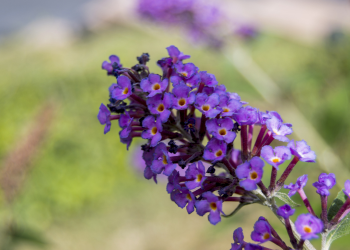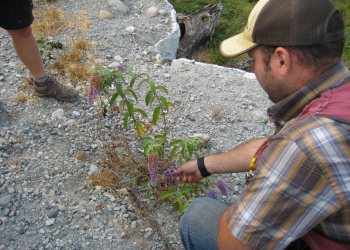Have you ever noticed all the bright purple flowers that grow next to the highway on your way down to Vancouver? We sure have – those are invasive Butterfly Bush plants.
This invasive plant is a quickly growing problem in the Sea to Sky. It outcompetes native vegetation by forming dense thickets, and by altering the nitrogen and phosphorous amounts in the soil. And, despite its name, it does not provide suitable habitat nor food sources for butterflies, as it only provides nectar for adult butterflies. Butterfly larvae cannot actually survive on Butterfly Bush. By competing with native vegetation that acts as a food source for the larvae, Butterfly Bush can actually have a negative impact on butterfly populations. Learn more about Butterfly Bush and its impacts here.
But if this plant is such an aggressive spreader, how come you don’t see much of it north of Squamish?

This map shows the distribution of Butterfly Bush in the Sea to Sky. As you can see, it’s clearly is abundant in the southern part of our region, and hardly present north of Squamish.
The red line just north of Squamish is a ‘containment line‘.
- To the north of (above) this line, our field crew is working to eradicate or prevent the spread of Butterfly Bush.
- To the south of (below) this line, our goal is to contain Butterfly Bush.
The spread of any invasive species depends on a number of different factors, including the plant’s preferred growing conditions, pathways of spread, and methods of dispersal.
Butterfly Bush has a strong preference for open, sunny areas. This includes roadsides, clear cuts, forest edges, riverbanks, boulder fields, and construction sites. These plants don’t do as well in extremely cold temperatures, but with a warming climate, Butterfly Bush is expected to be able to establish in new sites that were previously too cold for it to thrive. So, it’s becoming increasingly important for our field crew to monitor for this species in the northern part of our region.
Railways, powerline corridors, trails, and roads (including Highway 99), are major pathways for the spread of invasive species. SSISC works closely with the BC Ministry of Transportation and Infrastructure (MOTI) to prevent the spread of invasive plants along the highway. We work under an agreement with MOTI to control high priority invasive species in high priority locations. Unfortunately, there is not enough funding available to control them all, so you will likely see Butterfly Bush, and other invasive plants like Scotch Broom and Himalayan Blackberry south of their containment lines.
Butterfly Bush is extremely successful at reproducing, both by seed and vegetatively. This plant matures quickly and can produce seeds within the first year of growth. A single flower head can produce as many as 40,000 seeds, which are easily spread by water and wind, and remain viable in the soil for 3 – 5 years. If that seems like a lot of seeds, let’s not forget that each plant produces multiple flower heads!
Butterfly Bush can also sprout from broken branches, cut stems, or the rootstock. This means that cutting down Butterfly Bush and not removing all the plant material could lead to numerous new plants. Learn how to properly get rid of Butterfly Bush here.
Butterfly Bush was originally introduced to our region as an ornamental plant. However, due to its numerous negative environmental impacts, we’d like to encourage you to not grow, purchase, or trade this invasive plant. There are many beautiful, non-invasive alternatives – check them out in the Grow Me Instead Guide from the Invasive Species Council of BC.
You can help us prevent the spread of Butterfly Bush by reporting any sightings, especially those north of the containment line.






Add Comment